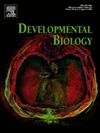Leveraging chicken embryos for studying human enhancers
IF 2.5
3区 生物学
Q2 DEVELOPMENTAL BIOLOGY
引用次数: 0
Abstract
The dynamic activity of complex gene regulatory networks stands at the core of all cellular functions that define cell identity and behaviour. Gene regulatory networks comprise transcriptional enhancers, acted upon by cell-specific transcription factors to control gene expression in a spatial and temporal specific manner. Enhancers are found in the non-coding genome; pathogenic variants can disrupt enhancer activity and lead to disease. Correlating non-coding variants with aberrant enhancer activity remains a significant challenge. Due to their clinical significance, there is a longstanding interest in understanding enhancer function during early embryogenesis. With the onset of the omics era, it is now feasible to identify putative tissue-specific enhancers from epigenome data. However, such predictions in vivo require validation. The early stages of chick embryogenesis closely parallel those of human, offering an accessible in vivo model in which to assess the activity of putative human enhancer sequences. This review explores the unique advantages and recent advancements in employing chicken embryos to elucidate the activity of human transcriptional enhancers and the potential implications of these findings in human disease.
利用鸡胚胎研究人类基因增强子
复杂基因调控网络的动态活动是决定细胞身份和行为的所有细胞功能的核心。基因调控网络包括转录增强子,由细胞特异性转录因子作用,以空间和时间特异性方式控制基因表达。增强子存在于非编码基因组中;致病性变异可破坏增强子活性并导致疾病。将非编码变异与异常增强子活性相关联仍然是一个重大挑战。由于它们的临床意义,长期以来人们对理解增强子在早期胚胎发生中的功能感兴趣。随着组学时代的开始,现在可以从表观基因组数据中识别假定的组织特异性增强子。然而,这种预测在体内需要验证。鸡胚胎发生的早期阶段与人类胚胎发生的早期阶段非常相似,这为评估假定的人类增强子序列的活性提供了一种可行的体内模型。本文综述了利用鸡胚胎来阐明人类转录增强子活性的独特优势和最新进展,以及这些发现在人类疾病中的潜在意义。
本文章由计算机程序翻译,如有差异,请以英文原文为准。
求助全文
约1分钟内获得全文
求助全文
来源期刊

Developmental biology
生物-发育生物学
CiteScore
5.30
自引率
3.70%
发文量
182
审稿时长
1.5 months
期刊介绍:
Developmental Biology (DB) publishes original research on mechanisms of development, differentiation, and growth in animals and plants at the molecular, cellular, genetic and evolutionary levels. Areas of particular emphasis include transcriptional control mechanisms, embryonic patterning, cell-cell interactions, growth factors and signal transduction, and regulatory hierarchies in developing plants and animals.
 求助内容:
求助内容: 应助结果提醒方式:
应助结果提醒方式:


